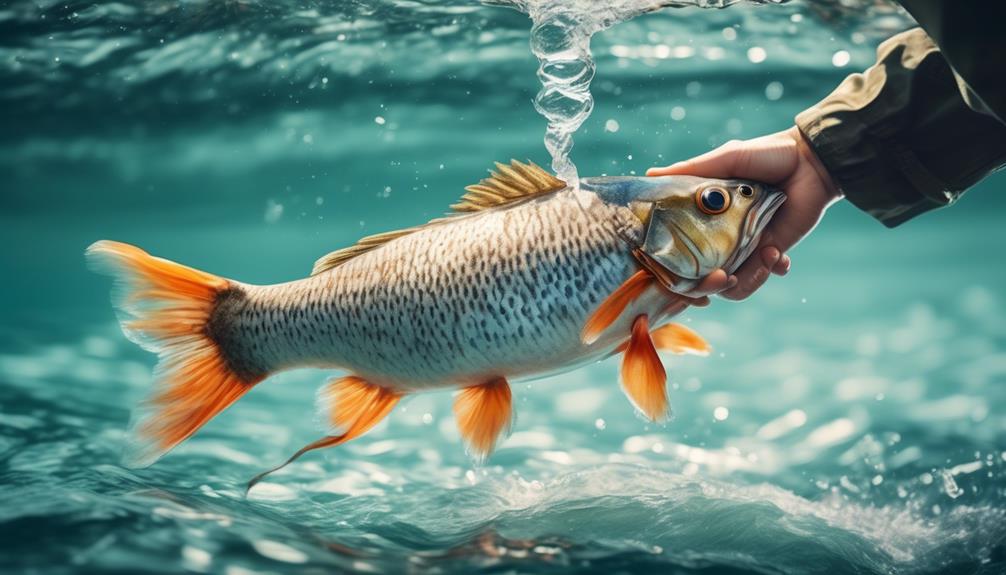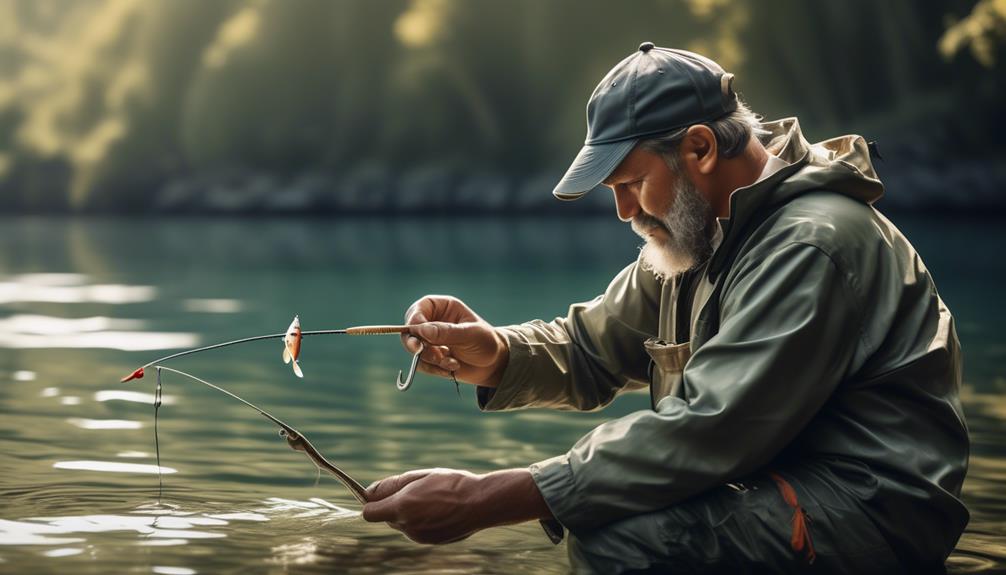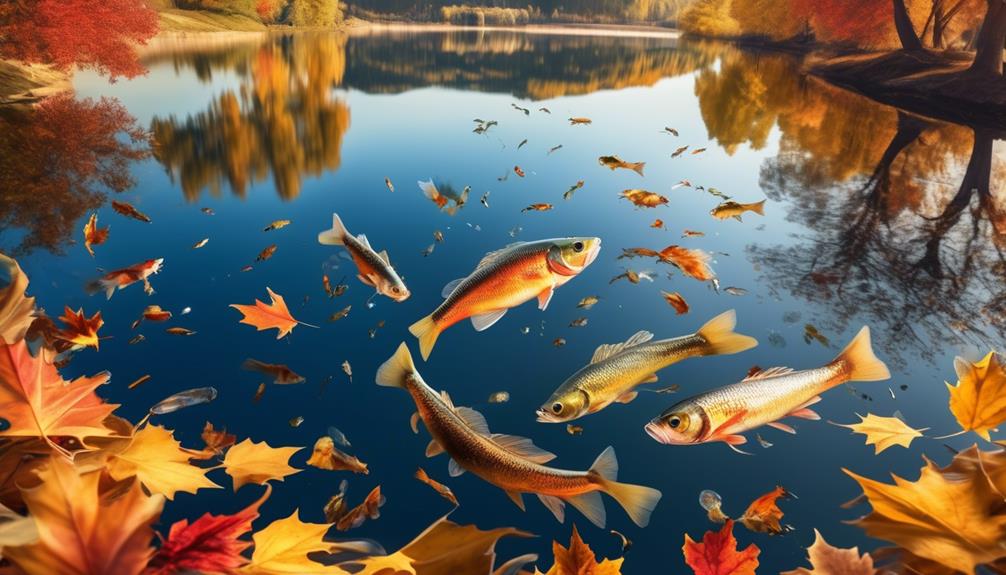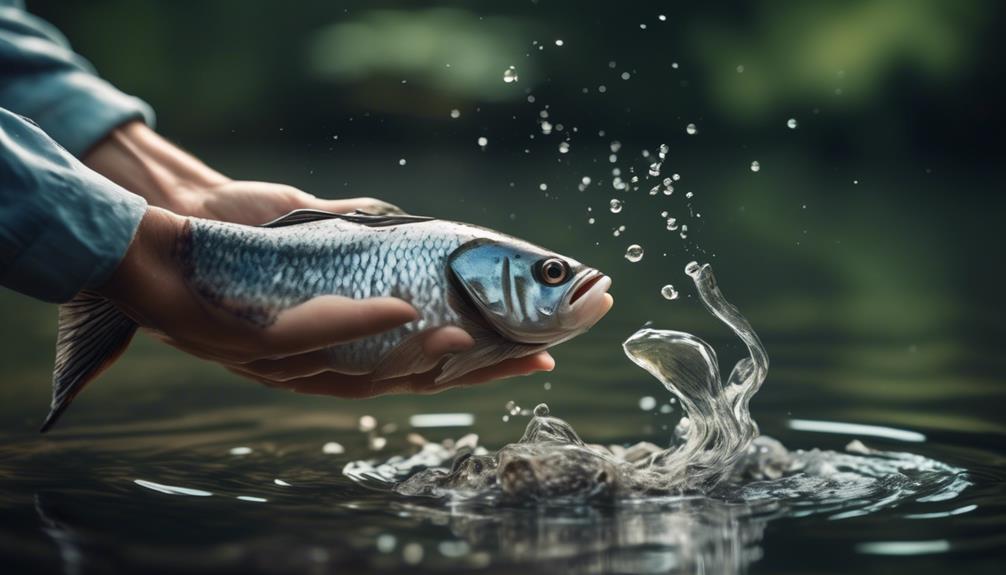When it comes to enjoying the sport of fishing while being mindful of conservation efforts, there are certain legal guidelines that can enhance your experience on the water.
Following these guidelines ensures that you are participating in catch and release practices in a responsible and ethical manner.
By understanding the best practices for catch and release, you can contribute to the sustainability of fish populations and the overall health of aquatic ecosystems.
So, what are the key legal guidelines to keep in mind when engaging in catch and release?
Legal Regulations for Catch and Release
When practicing catch and release, it's important to understand and comply with the legal regulations set forth by the relevant authorities. These regulations are in place to ensure the protection of fish populations and their habitats. Conservation efforts are at the forefront of these regulations, aiming to minimize the environmental impact of recreational fishing activities.
To address the environmental impact, authorities have established rules regarding catch and release practices. These rules often include guidelines on proper handling techniques, hook types, and fishing locations to minimize harm to the fish. By adhering to these regulations, anglers can actively contribute to conservation efforts and help maintain sustainable fish populations.
Understanding and abiding by these legal regulations not only protects the environment but also supports the long-term sustainability of fisheries. It's essential to stay informed about the specific catch and release laws in your area, as they can vary based on factors such as species, size limits, and designated conservation areas.
Fishing License Requirements
Before engaging in any fishing activities, ensure that you have obtained the necessary fishing license as required by the local regulations. Fishing license requirements vary by location, and it's crucial to familiarize yourself with the specific rules and regulations of the area where you plan to fish. In most regions, anyone over a certain age is required to obtain a fishing license before participating in any fishing activities. Age restrictions for obtaining a fishing license can vary, so be sure to check the local regulations to ensure compliance.
Fishing licenses play a vital role in the conservation efforts related to catch and release practices. By requiring anglers to obtain a license, authorities can better monitor and manage the fishing activities in a given area. The funds generated from fishing license sales often go toward conservation initiatives, habitat restoration, and fishery management programs, which ultimately contribute to the sustainability of fish populations and their habitats.
Additionally, fishing licenses help enforce catch and release regulations, ensuring that anglers are aware of and adhere to specific guidelines for releasing fish back into the water. These regulations are designed to protect fish populations and promote ethical and sustainable fishing practices. By obtaining a fishing license and familiarizing yourself with the catch and release guidelines, you can actively contribute to the conservation of fish species and their ecosystems.
It's important to note that fishing without a proper license can result in fines, penalties, or legal consequences. Therefore, it's in the best interest of both anglers and the environment to comply with fishing license requirements and regulations.
Protected Species and Seasons
Are you aware of the protected species and their respective seasons when engaging in fishing activities? It's crucial to be well-informed about the endangered species and fishing seasons to ensure responsible and legal fishing practices. Here are some important points to consider:
- Endangered Species: Familiarize yourself with the list of endangered or protected species in the area where you plan to fish. This information can usually be obtained from local wildlife conservation agencies or fisheries departments. It's essential to know which species are off-limits for fishing to avoid any potential legal consequences and to contribute to the conservation efforts.
- Fishing Seasons: Different species have varying fishing seasons, which are established to protect their reproductive cycles and ensure sustainable populations. Before heading out for a fishing trip, make sure to check the specific fishing seasons for the target species in your area. Adhering to these regulations helps in preserving the ecological balance and the long-term viability of the fish populations.
- Legal Restrictions: Be aware of any specific regulations or restrictions related to protected species and fishing seasons. These may include catch limits, size restrictions, or designated no-fishing zones during certain times of the year. Understanding and complying with these regulations are essential for the conservation of fish populations and their habitats.
- Conservation Efforts: Take an active role in conservation efforts by reporting any illegal fishing activities or violations related to protected species. By being a responsible angler, you contribute to the protection and preservation of endangered species for future generations to enjoy.
Being mindful of protected species and fishing seasons isn't only a legal obligation but also a moral responsibility to help safeguard the environment and aquatic life.
Handling and Release Techniques
To ensure the well-being of the fish and promote their survival after catching, mastering proper handling and release techniques is essential for responsible angling.
When handling a fish, always wet your hands to ensure the fish's protective mucus layer remains intact. Use a proper grip, supporting the fish under the belly and at the base of the tail. Avoid touching the gills or squeezing the fish tightly. This technique minimizes stress and potential injury to the fish. Additionally, using barbless hooks can make the unhooking process smoother and safer for both you and the fish.
When it comes to safe release, it's crucial to minimize the time the fish spends out of the water. Keep the fish in the water as much as possible while removing the hook. If you need to take a photo, do so quickly and support the fish properly, keeping it close to the water. Afterward, gently place the fish back into the water, facing the current to help oxygen flow through its gills. Ensure the fish is alert and able to swim away strongly before releasing it.
Use of Barbed and Barbless Hooks
Mastering proper handling and release techniques, especially when using barbed and barbless hooks, is crucial for responsible angling to ensure the well-being and survival of the fish. When deciding between barbed and barbless hooks for catch and release fishing, it's important to consider the impact on the fish and the environment. Here are some guidelines to help you make informed decisions about the use of barbed and barbless hooks:
- Consider the Fishing Equipment: When using barbed hooks, the potential for causing harm to the fish is higher due to the resistance encountered when removing the hook. In contrast, barbless hooks cause less damage during hook removal, which can contribute to the fish's post-release survival.
- Understand Conservation Practices: Conservation-minded anglers often opt for barbless hooks as they align with catch and release practices, promoting the ethical treatment of fish populations. By using barbless hooks, you can actively participate in conservation efforts and contribute to sustainable fishing practices.
- Evaluate Legal Regulations: Some fishing areas or specific regulations may mandate the use of barbless hooks to minimize harm to fish. Before heading out, familiarize yourself with the local fishing laws and regulations to ensure compliance and contribute to conservation efforts.
- Weight the Benefits: In addition to reducing harm to fish, using barbless hooks can also benefit anglers by simplifying hook removal, minimizing potential injuries, and facilitating a quicker release, allowing fish to recover more effectively.
Reporting Requirements for Released Fish
When releasing fish, it's important to be aware of any reporting requirements mandated by local fishing regulations to contribute to the monitoring and conservation of fish populations. Reporting requirements for released fish play a crucial role in the ongoing conservation efforts and the management of fish populations.
Many regions have specific regulations that require anglers to report certain information about the fish they release, such as species, size, and location of release. This information is invaluable for fisheries management and helps in assessing the health of fish populations, determining the effectiveness of catch and release practices, and making informed decisions for conservation efforts.
Fish tagging is also an important aspect of reporting requirements for released fish. In some areas, anglers are required to tag certain species of fish before releasing them back into the water. These tags provide valuable data when the fish is later caught again or when the tag is reported, offering insights into fish migration patterns, growth rates, and overall population dynamics. By reporting tagged fish, anglers contribute to valuable research and conservation efforts aimed at ensuring sustainable fish populations for future generations.
Understanding and complying with reporting requirements for released fish not only helps in the conservation of fish populations but also contributes to the overall sustainability of fisheries. By actively participating in reporting requirements, anglers play a vital role in the preservation of aquatic ecosystems and the responsible management of fish stocks.
Boundaries and Restricted Areas
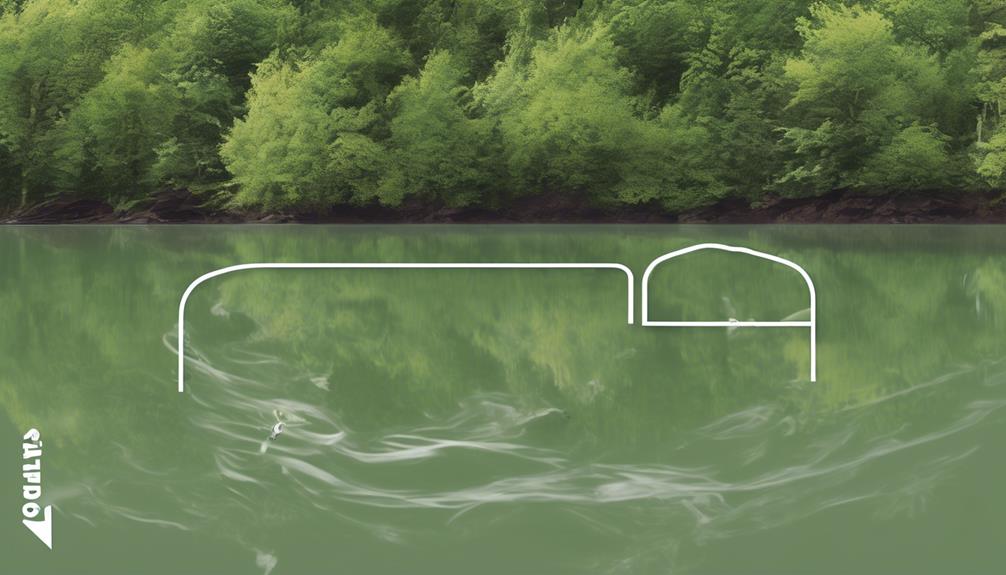
Reporting requirements for released fish, including tagging regulations, contribute to the effective management and conservation of fish populations, especially within boundaries and restricted areas. When fishing in restricted zones, it's crucial to adhere to specific guidelines to ensure the sustainability of fish populations and the overall health of the aquatic ecosystem.
Here are some essential considerations to keep in mind when navigating boundaries and restricted areas:
- Respect Boundary Markers: Always be aware of and respect boundary markers, such as buoys or signs, indicating restricted areas. These markers are in place to protect sensitive habitats and ensure the safety of fish populations.
- Research Restricted Zones: Before embarking on a fishing trip, take the time to research and familiarize yourself with any restricted zones in the area. Understanding the specific regulations and boundaries will help you avoid accidental violations.
- Adhere to Catch Limits: In restricted areas, strict catch limits are often enforced to prevent overfishing and support conservation efforts. It's important to comply with these limitations to maintain the balance of fish populations.
- Utilize Proper Gear: When fishing near restricted areas, consider using gear that minimizes the potential for unintentional bycatch or harm to protected species. By employing selective gear, you can support conservation efforts and contribute to sustainable fishing practices.
Liability and Ethical Considerations
Navigating the legal and ethical responsibilities of catch and release fishing requires a clear understanding of liability considerations. When engaging in catch and release fishing, it's crucial to be aware of the potential liability risks associated with this activity. While catch and release is generally considered a conservation-oriented practice, there are ethical dilemmas and liability concerns that anglers must address.
Liability risks can arise in catch and release fishing if proper care isn't taken to ensure the well-being of the fish. For instance, if a fish is improperly handled or released in a way that significantly reduces its chances of survival, there may be legal implications. Anglers should be mindful of the potential harm that could be caused to the fish during the catch and release process, as well as the environmental impact of their actions.
Ethical dilemmas also come into play when considering the well-being of the fish. As an angler practicing catch and release, it's important to prioritize the welfare of the fish and make every effort to minimize harm. This includes using barbless hooks, handling fish with wet hands, and minimizing air exposure.
Moreover, ethical considerations extend to the overall impact of catch and release fishing on fish populations and their ecosystems.
Frequently Asked Questions
Are There Any Specific Guidelines for Catch and Release in Fast-Moving Rivers or Streams?
When fishing in fast-moving rivers or streams, it's crucial to follow specific guidelines for catch and release.
Best practices for releasing fish in heavily populated fishing areas include using barbless hooks, minimizing air exposure, and avoiding unnecessary handling.
Additionally, it's important to handle fish gently and release them quickly to ensure their survival.
These guidelines not only promote conservation but also contribute to sustainable fishing practices in these environments.
What Are the Best Practices for Releasing Fish in Heavily Populated Fishing Areas?
When releasing fish in heavily populated fishing areas, it's crucial to prioritize proper handling and ethical angling practices. This includes using barbless hooks, minimizing air exposure, and promptly releasing the fish.
Additionally, avoid fishing in spawning areas and use appropriate gear to prevent unnecessary harm to the fish.
Are There Any Specific Regulations for Catch and Release in Lakes or Ponds With High Levels of Boat Traffic?
When catching and releasing fish in urban lakes, it's important to be aware of any specific regulations that apply to the area.
In crowded marinas, there may be additional rules to consider due to the high levels of boat traffic.
Always check with local authorities for any specific catch and release guidelines that may be in place.
Following these regulations can help protect the fish population and ensure a sustainable fishing environment for everyone.
What Should Anglers Do if They Accidentally Catch a Protected Species While Fishing?
If you accidentally catch a protected species while fishing, handle it with care and release it as quickly as possible. Use conservation methods like minimizing handling and using barbless hooks to reduce harm.
Follow the specific regulations for the protected species in your area and report the incident to the appropriate authorities.
It's important to prioritize the well-being of the protected species and contribute to their conservation efforts.
Are There Any Special Considerations for Catch and Release in Areas With Extreme Weather Conditions, Such as High Temperatures or Severe Storms?
When considering catch and release in icy conditions, it's crucial to prioritize the well-being of the fish. Avoid using barbed hooks to minimize harm, and handle the fish as little as possible to prevent freezing.
During heat waves, try to fish during cooler times of the day and use barbless hooks to reduce stress on the fish. Always follow local regulations and consider the impact of extreme weather on the fish before catch and release.
Conclusion
So, remember to always check the legal regulations for catch and release in your area. Make sure you have the proper fishing license and handle the fish carefully. Use the appropriate hooks to minimize harm to the fish.
Also, be aware of protected species and seasons. Report any released fish as required to contribute to conservation efforts. Always consider the ethical implications of catch and release, understanding the impact it has on the fish population and the environment.
By following these guidelines, you can enjoy the sport of fishing while also protecting the environment and the fish population.
